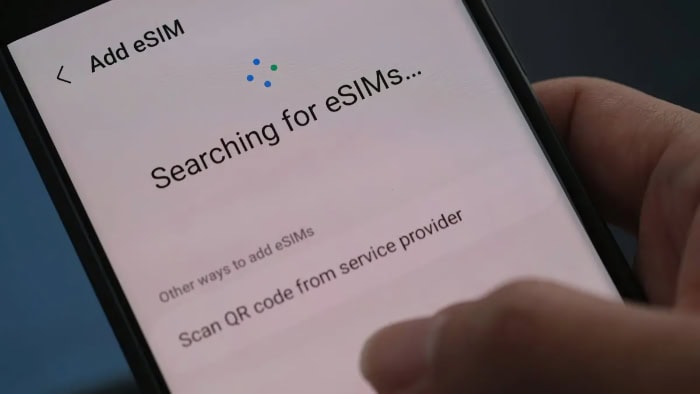What Is an eSIM and How Does It Work?

The small plastic SIM card that powers your phone is quickly becoming a relic. Its successor is the eSIM, a programmable chip built directly into your device’s hardware that does away with physical cards entirely.
This shift lets you activate a new cellular plan or switch carriers with a few simple screen taps. For travelers, it means adding a local data plan abroad is simple.
For professionals, it offers a straightforward way to keep work and personal lines separate on one phone. Before you make the switch, it is helpful to know how this technology functions, which devices and carriers support it, and the practical advantages and limitations of going fully digital.
What an eSIM Is
An embedded SIM, or eSIM, is a small chip permanently soldered onto a device's motherboard. Unlike a traditional SIM that you can physically remove and swap, an eSIM is a non-removable part of the hardware.
Its purpose remains the same; it stores the necessary information to authenticate your device with a mobile carrier and grant you access to its network. Because the chip is integrated, all setup and management tasks are handled through software, eliminating the need for a physical object.
Core Standards and Terminology
The technology relies on a set of industry-wide specifications to function correctly. The hardware itself is known as an embedded Universal Integrated Circuit Card (eUICC).
This secure chip can store multiple carrier “profiles.” A profile is a digital data package containing the information a physical SIM would normally hold, including your plan details and network credentials.
Each profile has standard identifiers like an ICCID and IMSI to communicate with cellular towers. The GSMA, an organization representing mobile operators worldwide, defines the technical standards for eSIMs, ensuring compatibility for consumer electronics as well as machine-to-machine (M2M) and Internet of Things (IoT) applications.
Device and IoT Integration
While smartphones, tablets, and smartwatches are the most common devices featuring eSIMs, the technology's application extends much further. It is a critical component in the rapidly expanding Internet of Things.
Connected cars, environmental sensors, smart-city infrastructure, and logistics trackers all benefit from eSIMs. Since these devices are often sealed to protect against the elements or located in hard-to-reach places, changing a physical SIM card is impractical or impossible.
An eSIM allows network providers to activate or update them remotely, simplifying the management of thousands or even millions of connected units.
How an eSIM Works

The operation of an eSIM relies on a secure, over-the-air process that gives network carriers the ability to remotely manage a device's cellular connection. This system is designed to be both secure and flexible, moving the entire lifecycle of a SIM from a physical object to a digital one managed through software.
It enables activation, profile switching, and updates without ever needing to open a SIM tray.
Remote Profile Provisioning
Instead of inserting a plastic card, activating an eSIM involves a process called remote provisioning. Carriers provide users with a QR code or a download link.
When a user scans the code or follows the link, the device securely downloads a digital “profile” from the carrier's server. This profile contains all the necessary data to connect to the network.
The device's embedded Universal Integrated Circuit Card (eUICC) then installs and protects this profile. This same remote method allows carriers to send updates or even delete a profile when a customer cancels service, all without any physical interaction.
Security and Trust Model
The digital nature of eSIMs is protected by robust security measures that are equivalent to those of traditional SIM cards. The eUICC chip is a secure element, which is a tamper-resistant hardware component designed to safeguard sensitive data and cryptographic keys.
All communication between the carrier's provisioning server and the device's eUICC is fully encrypted. The entire framework operates under strict specifications set by the GSMA, ensuring that your cellular identity cannot be easily intercepted or cloned during the download and activation process.
Software-Based Profile Management
A key function of eSIM technology is the ability to store multiple carrier profiles on a single device. Most modern smartphones allow you to have several profiles downloaded and stored simultaneously, even if only one or two can be active at any given time.
Users can switch between different lines, such as a personal number and a work number, directly from the device's settings menu. This software-based control makes it simple to change plans or add a temporary line for travel without needing to acquire and swap physical cards.
Compatibility and Activation
Before you can use an eSIM, you must first ensure that your device, mobile carrier, and desired plan all support the technology. The process of getting connected is entirely digital, but it requires a compatible phone and a participating network.
Activation is typically straightforward and can be completed in just a few minutes directly from your device.
Confirming Device Support
eSIM functionality is dependent on a device's hardware and operating system. Most flagship smartphones and many mid-range models from major manufacturers like Apple, Samsung, and Google now include an embedded SIM.
The easiest way to check for compatibility is to look in your phone’s cellular or mobile data settings for an option like “Add Cellular Plan” or “Add eSIM.” If that option is present, your device is equipped for it.
Support is also common in modern tablets and smartwatches, but it is always best to verify the specifications for your exact model before purchasing a plan.
Verifying Carrier and Plan Support
Just because a device is eSIM-capable does not mean every mobile carrier supports it. Major network operators worldwide have widely adopted eSIMs, but availability can differ among smaller carriers or regional providers.
Furthermore, some carriers may only offer eSIMs for certain types of plans, such as postpaid accounts, and not for prepaid options. Before attempting to switch, check the carrier’s website or contact its support team to confirm that they provide eSIM services for your device and plan type.
This is especially important when planning for international travel, as you will want to verify local carrier support in your destination country.
Streamlined Activation Processes
Activating an eSIM is designed to be a simple, self-service process. There are three common methods for downloading and installing a carrier profile onto your device.
- QR Code Scan: The most popular method involves the carrier providing you with a QR code, either through an email, on a physical card, or in your online account portal. You simply use your phone's camera to scan the code, which prompts the device to download and install the cellular profile automatically.
- In-App Activation: Many carriers have streamlined the process by integrating it into their official mobile apps. After logging in, you can select an option to activate a new eSIM, and the app will handle the profile installation for you.
- Manual Configuration: In some cases, a carrier may provide activation details that you can enter manually. This usually involves navigating to your phone's cellular settings and inputting a server address and activation code provided by the network.
Benefits and Use Cases

The shift to an integrated digital SIM introduces practical advantages that change how people manage their mobile connectivity. By removing the physical card from the equation, eSIMs offer greater flexibility for daily use, simplify the process of staying connected while traveling, and allow for more efficient management of multiple phone lines on a single device.
Digital Convenience and Flexibility
The most immediate benefit of an eSIM is the convenience it offers. There is no longer a need to wait for a physical SIM card to be shipped or to visit a store to pick one up.
Activation can be completed from anywhere with an internet connection in just a few minutes. This streamlined onboarding process also makes it much easier to switch between carriers.
If you find a better plan with a competing provider, you can purchase and activate their service directly on your phone without needing to acquire and insert a new plastic card.
Simplified International Travel
For frequent travelers, eSIMs are exceptionally useful for avoiding high international roaming charges. Upon arriving in a new country, you can purchase a local or regional data plan from a provider online and activate it instantly.
This gives you access to affordable mobile data without needing to hunt for a local store selling physical SIM cards. Furthermore, since devices can keep multiple profiles, you can maintain your primary phone number for receiving calls and text messages while using the secondary eSIM for all your data needs.
Managing Multiple Lines on One Device
An eSIM makes it possible to have two or more phone lines on a single handset, a useful feature for anyone wanting to separate personal and professional communications. You can have a dedicated business number and a personal number both active on the same phone.
Your device’s settings allow you to choose which line to use for outgoing calls, messages, and which plan should provide cellular data. This eliminates the need to carry two separate phones and simplifies the process of managing different aspects of your life.
Limitations and Practical Considerations
While eSIM technology offers significant convenience, it is not without its drawbacks and practical challenges. The transition from physical SIM cards to an embedded digital format is still ongoing, and as a result, users may encounter inconsistencies in availability and support.
It is also important to be aware of how processes like transferring service to a new phone differ from traditional methods.
Uneven Carrier and Plan Support
The most significant hurdle for eSIM adoption is inconsistent availability. While most major carriers in developed markets offer eSIM options, support can be limited or nonexistent with smaller regional carriers, budget mobile virtual network operators (MVNOs), and in many parts of the world.
Additionally, some carriers might restrict eSIMs to more expensive postpaid plans, excluding them from prepaid or pay-as-you-go options. This patchwork of availability means you must always verify that a specific carrier and plan support eSIM for your device before making a switch.
The Process of Transferring an eSIM
Moving your cellular service to a new phone is less direct with an eSIM compared to a physical card. You cannot simply take the SIM out of your old device and place it into a new one.
Instead, you must transfer the eSIM profile. While many operating systems and carriers have developed quick transfer tools that can move a profile wirelessly between devices, the process can sometimes require you to contact your carrier to deactivate the profile on the old device and receive a new QR code to activate it on the new one.
This adds an extra step that can be cumbersome, especially if you are upgrading phones frequently.
Fixed and Non-Removable Hardware
The integrated nature of an eSIM is both a strength and a weakness. Because the chip is permanently part of the device's motherboard, it cannot be physically removed.
If your phone suddenly breaks or the battery dies, you lose the ability to quickly swap your SIM into a spare or backup phone to make an urgent call or send a text. In such situations, your only option is to acquire a new device and go through the full provisioning process again to regain access to your cellular service.
Conclusion
The eSIM represents a significant step forward in mobile connectivity, replacing the physical SIM card with a more flexible and integrated digital alternative. Its secure, software-based approach simplifies how we activate service, switch between carriers, and manage multiple phone lines on a single device.
For travelers, it provides an immediate way to access local data plans without incurring high roaming fees. While the technology's full potential is still limited by gaps in device and carrier support, its practical benefits are clear.
As adoption continues to grow, confirming compatibility and knowing the activation steps are the final checks before embracing a more convenient way to stay connected.


